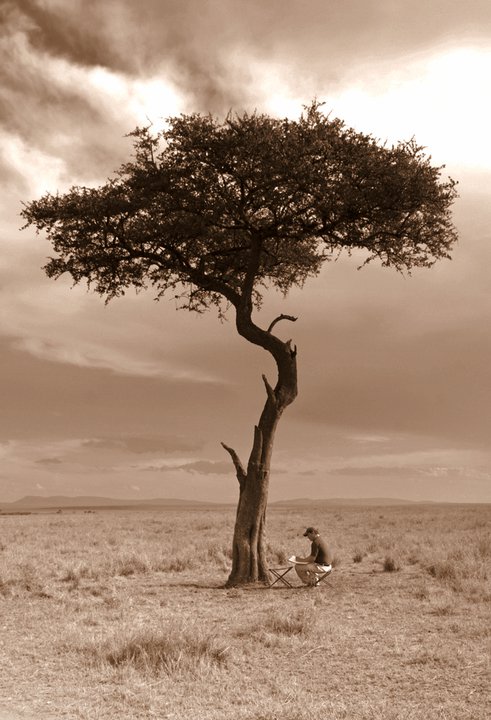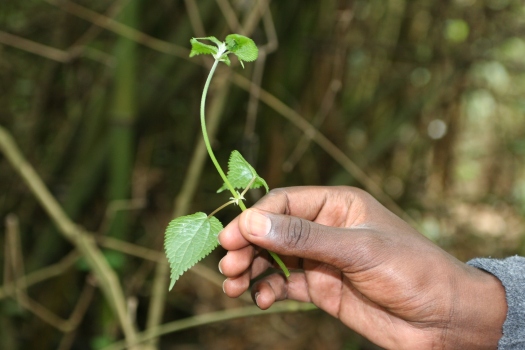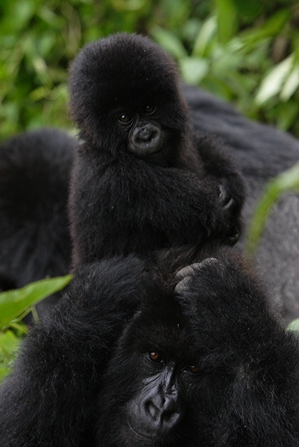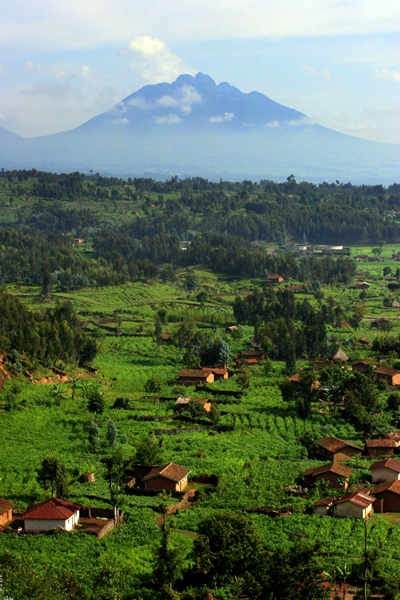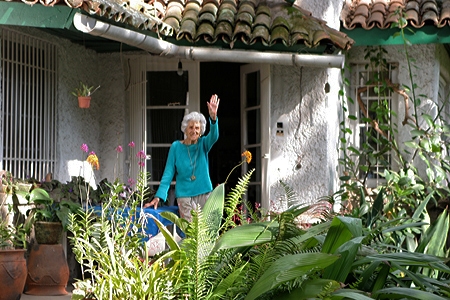Join me as I research new paintings in such spectacular African wildlife destinations as Kenya’s Masai Mara National Reserve, Rwanda’s Parc National des Volcans, and Tanzania’s Serengeti National Park– then follow me back to my studio in the USA where, step by step, I’ll bring the paintings to life. Thanks for visiting my website! — Charles Alexander
Atop Lookout Hill, Masai Mara National Reserve, Kenya
 Although gathering photographic reference–especially of animals in motion– is of paramount concern while on safari, the chance to sit and sketch offers multiple rewards. Doing so forces me to slow down, encourages me to become more attuned to my surroundings, and, most importantly, helps me to identify interesting shapes, patterns, and motifs everywhere around me. A single sketch completed in the field is indelible– much like writing something down is an aid to memory. I treasure the opportunity to field sketch in Africa, particularly in the Masai Mara in Kenya. The Mara is a combination of very seductive elements– wide-open landscapes, the migration crossings at the Mara River, the abundance of big cats–that make it an incomparable field of exploration for the artist.
Although gathering photographic reference–especially of animals in motion– is of paramount concern while on safari, the chance to sit and sketch offers multiple rewards. Doing so forces me to slow down, encourages me to become more attuned to my surroundings, and, most importantly, helps me to identify interesting shapes, patterns, and motifs everywhere around me. A single sketch completed in the field is indelible– much like writing something down is an aid to memory. I treasure the opportunity to field sketch in Africa, particularly in the Masai Mara in Kenya. The Mara is a combination of very seductive elements– wide-open landscapes, the migration crossings at the Mara River, the abundance of big cats–that make it an incomparable field of exploration for the artist.
Sketching in the wild: this is uhuru, this is freedom. Just to sit and be still long enough to allow the senses–especially the eye– to awaken…this is when you begin to notice the miniature worlds underfoot, the brown lark in the grass, the textures of ancient rock, the subtle shadings of the atmosphere on a clear and brilliant day…
New Migration Crossing Composition: Underdrawing
A look at the underdrawing on canvas of my new migration crossing composition, scaled up from my smaller working drawing.  The concept is “order within chaos”: depicting the crush of bodies, the atmosphere of dust, and the repeating motifs encountered at water’s edge at a Great Migration Mara River crossing…
The concept is “order within chaos”: depicting the crush of bodies, the atmosphere of dust, and the repeating motifs encountered at water’s edge at a Great Migration Mara River crossing…
 You can get a more accurate sense of scale when I stand next to it. This piece measures 32 x 60″, linen mounted on panel (one of 14 such works currently in the studio). Now to begin the color ebauche underpainting: a thin wash of the basic color palette that I will use for the opaque layers of the painting…
You can get a more accurate sense of scale when I stand next to it. This piece measures 32 x 60″, linen mounted on panel (one of 14 such works currently in the studio). Now to begin the color ebauche underpainting: a thin wash of the basic color palette that I will use for the opaque layers of the painting…
Memorial to Michael and Bernhard Grzimek, Ngorongoro Conservation Area, Tanzania

In 1957 Bernhard Grizmek, director of the Frankfurt Zoo, traveled to East Africa with his son Michael to conduct aerial surveys of the Serengeti, particularly of the wildebeest migration, in order to determine boundaries for the newly-established national park. Michael was killed in 1959 when the Grzimek’s zebra-striped Dornier aircraft crashed after colliding with a griffon vulture. The elder Grzimek died in 1987 and was buried per his request at his son’s resting place on the rim of the Ngorongoro Crater, one of the most beautiful spots on earth. Learn more about the Grzimek’s pioneering conservation efforts at the Serengeti National Park’s official site: http://www.serengeti.org/p_grzimek_m.html
Eyes of Virunga: From Fieldwork to Studio, Part I

I’d like to start my posts here at Artist In Africa by discussing the creation of the above painting– Eyes of Virunga: Mountain Gorilla (pastel, 18 x 24″). Over the next several posts, I’ll take you from field research in Africa to work in my studio in the USA as I revisit the long journey that went into the making of this piece. Feel free to come along and share the adventure!
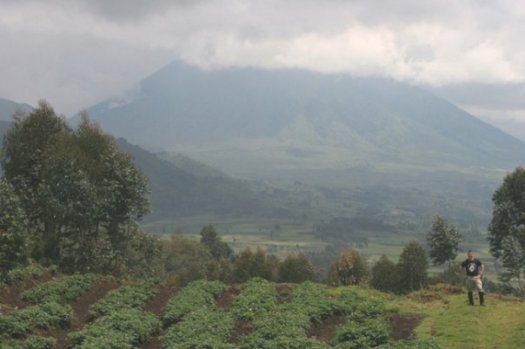
Eyes of Virunga: Mountain Gorilla represents a first in a series of gorilla paintings researched in Rwanda’s Parc National des Volcans on the slopes of the majestic Virunga volcanoes. The world of the mountain gorilla is just as ethereal, mist-shrouded, and hauntingly beautiful as I had ever imagined. Here, I am standing in the patchwork of fields that literally cloaks the entirety of the Rwandan countryside. Rwanda is the most densely populated nation in Africa– and its volcanic soil incredibly rich. Every square inch of ground is cultivated, right up to the edge of the Parc National des Volcans.
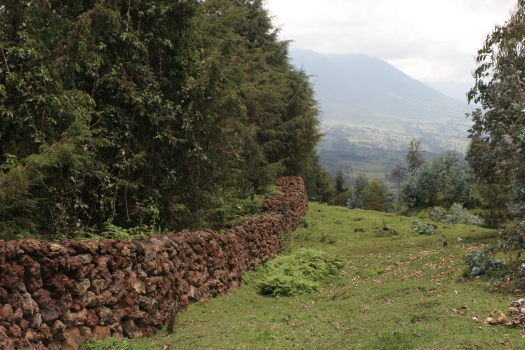
The world of the mountain gorilla is clearly demarcated from the busy human world of villages and fields by this low wall of porous volcanic rock. The mountain gorillas and the countless other organisms that share their island of habitat are quite literally castaways, adrift in a burgeoning sea of humanity.

Once inside the park, the landscape of patchwork fields and rural villages abruptly vanishes– replaced by a great zone of bamboo in the lower elevations and montane forest on the volcanoes’ upper reaches. Here, the slopes of Mt. Bisoke provide a home for the Amahoro gorilla family. Today they are over an hour away, so let’s get moving…
Eyes of Virunga: From Fieldwork to Studio, Part 2

Before continuing with our gorilla trek, I’d like to tell you a bit about my accommodations in Rwanda at Volcanoes Safaris’ Virunga Lodge, a once-in-a-lifetime getaway that can best be described in a single, all-encompassing word: spectacular. Virunga Lodge boasts one of the most jaw-dropping views in all of Africa: 360 degrees taking in the entire Virunga volcano chain plus the beautiful volcanic lakes Ruhonda and Bulera. I feel very fortunate to have had a chance to experience not only the incredible view, but also the lodge’s exceptional cuisine and very friendly staff. Few places in Africa can equal what Virunga has to offer.

Sunset over the Virunga volcanoes from the grounds of Virunga Lodge. East Africa is home to eight Virunga volcanoes: the three shown here (left to right) Sabinyo, Mgahinga, Muhabura, plus Bisoke, Karasimbi, Mikeno, Nyiragongo, and Nyamurigira. The Virunga chain extends for close to 50 miles along East Africa’s Albertine Rift, straddling the converging borders of Rwanda, Uganda, and the Democratic Republic of Congo. The explorer John Hanning Speke was the first European to spot the Virungas in 1861. Five of the volcanoes are dormant, but Nyiragongo and Nyamurigira are active indeed– having erupted as recently as 2006. The Karisoke Research Center, founded by Dian Fossey in 1967 as a hub of mountain gorilla research, was located in the saddle area between Karisimbi and Bisoke. The original center was destroyed during the Rwandan genocide in 1994.

Another view of Mt. Muhabura from my ravens-nest perch on the lodge grounds. Muhabura means “The Guide”, so called because the majestic cone of the mountain can be seen as a landmark from a great distance. Still, Muhabura at 13,540 feet (4127 meters) is only the third tallest of the Virungas, behind Mikeno and Karasimbi. At 14,787 feet (4,507 metres), Karasimbi’s peak is occasionally blanketed in snow.

When an afternoon thunderstorm sweeps across the Virungas here, the view from the lodge veranda is transformed into a J.M.W. Turner painting come to life.

The African white-naped raven (Corvus albicollis) is easily seen on the immaculate grounds of Virunga Lodge.

I have long been interested in these birds, ever since first reading George Schaller’s Year of the Gorilla. Schaller was the first scientist to study mountain gorilla ecology and behavior in the wild. Year of the Gorilla is Schaller’s popular account of his year long study of the gorillas in the Virunga highlands in 1959-60 (pre-dating Fossey by six years). Of Mt. Mikeno’s white-naped ravens, Schaller wrote: ” On days when the warm air from the lowlands rushed up the canyons, or the winds howled and the thunder grumbled around the upper slopes of Mt. Mikeno, the ravens played their airy games. Like black messengers from Thor, they emerged out of the wind-tattered clouds, rushing downward with folded wings, until abruptly they veered skyward and disappeared, only a disembodied krrrua-krrrua echoing from the clouds.”
Eyes of Virunga: From Fieldwork to Studio, Part 3
Today I’d like to tell you about securing that all-essential gorilla permit. One can’t simply arrive in mountain gorilla country, hire a guide and porters as artists and adventurers like Carl Akeley did close to a century ago, and hike up the Virunga volcanoes swashbuckler-style in search of the largest of the great apes:

Today mountain gorilla trekking is a fast-growing, multi-million dollar industry for Rwanda, an industry that not only brings in much-needed foreign currency, but also keeps the gorillas and the other creatures that share their montane forest world alive. Without an economic incentive, the Parc National des Volcans would have been cleared for agriculture and the gorillas driven to extinction long ago. As you can easily see upon arrival in this aptly-named Land of a Thousand Hills, very little of the natural world remains in Rwanda:
 Terraced fields a few miles outside Kigali
Terraced fields a few miles outside Kigali
So protection of the Parc National des Volcans and its precious wildlife via tourist dollars is a win-win for both the natural world and for those who come so far to experience what remains of Rwanda’s wild heritage. With thousands of gorilla trekkers arriving every year, however, strict rules have been laid down to protect both the safety of visitors and the mountain gorilla families they’ve arrived to meet. Currently, seven habituated gorilla groups in Parc National des Volcans are open to tourist visits, with 8 permits available for each group per day. That’s only 56 permits daily in Rwanda, so you can easily see why these must be must booked at least 6 -12 months in advance in order to guarantee your preferred travel dates. Each permit costs US$500 per person per tracking and allows you a one hour visit with a habituated gorilla family.
 Ubumwe, silverback of the Amahoro Group
Ubumwe, silverback of the Amahoro Group
I purchased six gorilla permits, plus another for golden monkeys, eight months in advance through Volcanoes Safaris, one of the top gorilla trekking travel companies. I felt that a minimum of six gorilla treks would give me a better chance for good photos in optimum light (not a bad idea, as it turned out). Even that far ahead my schedule required adjustment in order to secure that many permits. Fortunately, however, arrangements were soon finalized– and I arrived in Rwanda’s capital city of Kigali, thrilled by the prospect of seeing mountain gorillas and golden monkeys in the ethereal beauty of their native habitat. After a quick lunch at the famed Hotel des Milles Collines ( “Hotel Rwanda”) my driver/guide Ammon and I were off, headed toward Ruhengeri and Volcanoes Safari’s magnificent Virunga Lodge.
 A colorful, rain-soaked street scene in Kigali
A colorful, rain-soaked street scene in Kigali
 Mountain road on the way to Ruhengeri. As you can see, the main highways here are very well maintained.
Mountain road on the way to Ruhengeri. As you can see, the main highways here are very well maintained.
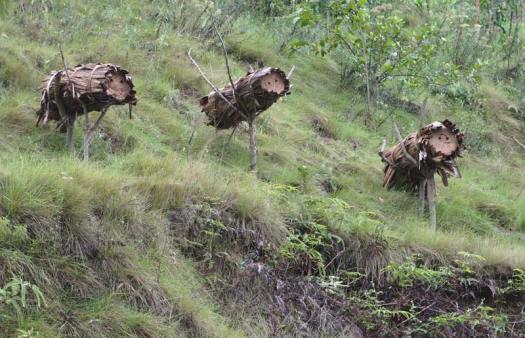 Traditional Rwandan beehives along the road.
Traditional Rwandan beehives along the road.
 I’ll never forget my first glimpse of the towering Virunga volcanoes as we approached Ruhengeri.
I’ll never forget my first glimpse of the towering Virunga volcanoes as we approached Ruhengeri.

Next post: A crash course in gorilla etiquette at park headquarters– and our first gorilla trek begins…
Eyes of Virunga: From Fieldwork to Studio, Part 4
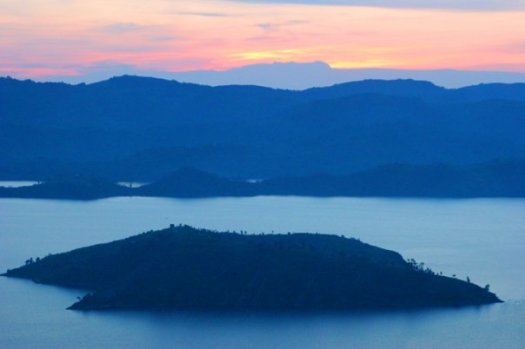
Ready for today’s visit with the Amahoro gorilla family? Eating a quick breakfast before dawn and being ready to go by first light is imperative if we’re to make it in time. We have a half hour drive ahead of us: winding down the mountain from our lofty Virunga Lodge perch, through local villages along a bumpy dirt road with an incomparable view of the volcanoes, to Parc National des Volcans headquarters at Kinigi. Once there, we’ll officially check in with park officials and receive a quick briefing re our assigned gorilla family. As the sun rises over the beautiful Rwandan hills, flooding the sky and the waters of volcanic Lake Bulera below my banda with color, it is time to leave for the day’s adventure.
 My driver-guide Ammon of Volcanoes Safaris is a total professional: knowledgeable, patient, eager to share the beauty of Rwanda, and ready to solve any and all problems. He will negotiate with park officials this morning for assigment to my desired group: the Amahoros, a family presided over by the great, gentle silverback Ubumwe. This will be my second visit to the Amahoros, as I want to take a few more reference shots of the silverback and also of the group’s boisterous youngsters at play. Let’s hope that park officials will be accommodating. If the permits for Amahoro have already all been assigned, we’ll have to go with a different group.
My driver-guide Ammon of Volcanoes Safaris is a total professional: knowledgeable, patient, eager to share the beauty of Rwanda, and ready to solve any and all problems. He will negotiate with park officials this morning for assigment to my desired group: the Amahoros, a family presided over by the great, gentle silverback Ubumwe. This will be my second visit to the Amahoros, as I want to take a few more reference shots of the silverback and also of the group’s boisterous youngsters at play. Let’s hope that park officials will be accommodating. If the permits for Amahoro have already all been assigned, we’ll have to go with a different group.
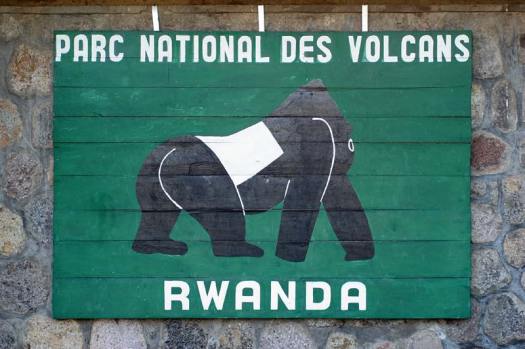
At park headquarters, the grounds are alive this morning with brilliantly colored sunbirds feeding on the many flowering plants that grow so easily and abundantly in Rwanda’s rich volcanic soil. The jagged peak of Mt. Sabinyo looms above us and the cawing of pied crows and the bleating of goats being driven along the road are heard as we wait for word of our permits.
 Others too are waiting here: people from many nations have gathered in the brisk morning air, all eager to trek into the mountains so close at hand to meet the largest of the great apes face-to-face. At last, Ammon emerges from the park office with a smile and good news: our permit for Amahoro has been approved and our trek is about to begin. But first, let’s take a brief but essential crash course in gorilla etiquette.
Others too are waiting here: people from many nations have gathered in the brisk morning air, all eager to trek into the mountains so close at hand to meet the largest of the great apes face-to-face. At last, Ammon emerges from the park office with a smile and good news: our permit for Amahoro has been approved and our trek is about to begin. But first, let’s take a brief but essential crash course in gorilla etiquette.

We meet our guide Innocente, as well as the other six trekkers assigned to Amahoro, at the sign corresponding to our gorilla family name. Innocente introduces himself and quickly tells us the basics: no getting closer to the gorillas than 7 meters (21 feet); if a curious gorilla moves closer than that distance, it is imperative to quietly fall back under the guide’s direction to maintain the safety not only of the human visitors, but also of the gorillas, who are susceptible to human diseases; leave no trash and never spit in the forest; if you must cough or sneeze, please cover your face and turn away; if you are ill this morning, you may not visit the gorillas; no pointing at the gorillas as this alarms them; please speak softly and make no sudden movements; in the rare event that a gorilla should behave aggressively or even charge: do not run, keep low, look away, and follow Innocente’s explicit instructions; no eating or drinking when in the presence of the gorillas; no flash photography allowed, as this alarms them; and also no monopods or tripods as “sticks” frighten the gorillas and may enrage the silverback. Finally: a gorilla permit is no guarantee of seeing a gorilla family, but your guide and the trackers already at work in the forest to locate the Amahoros will do their best. A photograph of the Amahoro family. Each gorilla has a unique noseprint that is easily identifiable. The group has 14 members, ranging in age from the elder silverback to curious toddlers. Eager to meet them? Time to get going…
A photograph of the Amahoro family. Each gorilla has a unique noseprint that is easily identifiable. The group has 14 members, ranging in age from the elder silverback to curious toddlers. Eager to meet them? Time to get going…
Eyes of Virunga: From Fieldwork to Studio, Part 5
Today I’ll at last take you to meet the Amahoros. I can think of no better way to impart the sights, sounds, and emotions of the journey than to share a page from my Rwanda journal, written while my impressions of the day were at their most vivid:
” Last day in Rwanda. This morning I tracked the Amahoro group of gorillas for a second time– they were so close to the wall of porous lava stones that surrounds the Parc National des Volcans that we could hear the tinkle of goat bells, the lowing of cattle, and the laughter of the shepherd boys drifting up from the fields beyond the wall.
 And yet I felt that I was 10,000 years in Rwanda’s past: surrounded by giant lobelias, stinging nettles, and a thousand other kinds of plants, literally immersed in a “gigantic gorilla salad bowl” as so many have described it.
And yet I felt that I was 10,000 years in Rwanda’s past: surrounded by giant lobelias, stinging nettles, and a thousand other kinds of plants, literally immersed in a “gigantic gorilla salad bowl” as so many have described it.
It is truly a shock to leave the world of cultivated fields with a porter and children at your heels, and then to enter the park and follow guide and trackers through the cool shadowy tangle of undergrowth, suddenly hearing the quick pock pock pock of a gorilla beating its chest…
…and an even greater shock to walk a bit more and discover an entire family of mountain gorillas lounging only 15 feet away, framed by lush vegetation as they take their mid-morning siesta after several hours of early morning feeding.
The Amahoros had made their day nests by the time we arrived, flattening the vegetation, and were framed all around by exquisitely formed lobelias, then by groves of native bamboo in the mid-distance, followed at last by the mist-shrouded peak of Mt. Bisoke itself. The gorilla mothers spend most of their rest time watching their hyperactive children at play while silverback Ubumwe keeps an eye on every group member.
 Even when napping his senses are attuned to any hint of danger that might threaten the safety of his family. He is always making deep rumbling sounds to communicate his orders to the group and is also quick to break up a squabble with little more than a rumble and a look.
Even when napping his senses are attuned to any hint of danger that might threaten the safety of his family. He is always making deep rumbling sounds to communicate his orders to the group and is also quick to break up a squabble with little more than a rumble and a look.
The young ones spend most of the group’s rest time climbing over the ever-patient adults and playing games. This morning one youngster climbed on his mother’s head and waved and beat his chest.
I am going to miss Rwanda– the spectacular terraced fields that make a patchwork of the Virunga landscape right to the edge of the Parc National des Volcans…
……the excited children racing alongside the vehicle, smiling and showing me how fast they can run and calling ” Agachupa!” (plastic bottle!); the beautiful faces of the farm workers in the fields and along the road– the women invariably dressed in brightly colored cloths, some balancing heavy loads on their heads…
the spontaneous singing and dancing of the mercurial, mysterious Batwa…
 Driving the bumpy roads crowded with people and livestock (Rwanda is the most densely populated nation in Africa) while Ammon teaches me Kinyaruanda; arriving at the park headquarters at first light and waiting to begin the morning’s tracking while watching black kites and pied crows on the wing with the peaks of the Virunga volcanoes, particularly jagged Mt. Sabinyo, forming a spectacular and somewhat otherwordly backdrop…
Driving the bumpy roads crowded with people and livestock (Rwanda is the most densely populated nation in Africa) while Ammon teaches me Kinyaruanda; arriving at the park headquarters at first light and waiting to begin the morning’s tracking while watching black kites and pied crows on the wing with the peaks of the Virunga volcanoes, particularly jagged Mt. Sabinyo, forming a spectacular and somewhat otherwordly backdrop…
Driving to the starting point at a local village and meeting my porter; walking through miles of fields to the edge of the park, watched along the way by child shepherds tending herds of cattle and goats–I say ” Amarantze, amokoro ki?”– their eyes light up as they respond somewhat shyly with ” Aygo–nemeza”…
…arriving at the stone wall that surrounds the park, then vanishing along a trail into the bamboo zone as we climb to keep our appointment with the day’s assigned gorilla family…
 hearing the cries of golden monkeys and touracos along the way; listening to the wind in the tall bamboo as the stalks creak and groan; savoring the clean, cold mountain air as we climb through meadows of stinging nettles, lobelias, and wild celery, sometimes at a 45 degree angle, sometimes on hands and knees through dense thickets…
hearing the cries of golden monkeys and touracos along the way; listening to the wind in the tall bamboo as the stalks creak and groan; savoring the clean, cold mountain air as we climb through meadows of stinging nettles, lobelias, and wild celery, sometimes at a 45 degree angle, sometimes on hands and knees through dense thickets…
 …then sitting peacefully for an hour as I did this morning: surrounded by gorillas and watching them nap and play.
…then sitting peacefully for an hour as I did this morning: surrounded by gorillas and watching them nap and play.
Meeting Roz Carr yesterday afternoon and being welcomed into her home in Gisenyi felt unreal. She has been a hero of mine for close to 20 years–certainly she was everything that I ever imagined her to be: the most loving and courageous person that I’ve ever met.
Mrs. Carr first arrived in Rwanda in 1949– and soon fell in love with the land and its people. Her memoir Land of a Thousand Hills: My Life In Rwanda is essential reading for those interested in this part of Africa. A friend to Dian Fossey, Mrs. Carr was portrayed by the actress Julie Harris in the film Gorillas In The Mist. Shortly after the 1994 genocide in Rwanda–and at the age of 82- she founded the Imbabazi Orphanage at Mugongo Plantation, which has subsequently saved hundreds of Rwandan children from a life on the streets.
Dining later on the terrace at the Kivi Sun Hotel in Gisenyi, on the shore of the gigantic Lake Kivu ( the Congolese border only a mile away) we witnessed the arrival of family and guests to a Tutsi wedding: the tall Tutsi women all in elegant brightly colored robes, the groom in a military uniform; the rusty clunky military band, wheezing out a tired old march, followed by the distinctive contrast of drums speaking clearly and powerfully. Soon, the singing and dancing of the Intore drifted across the grounds as the wedding celebration reached fever pitch.
I walked along the lake shore after dinner, listening to the echo of drums while children splashed in the shallows (no hippo or crocodiles in Lake Kivu) and Europeans strolled the beach; finally driving back to Ruhengeri–the giant active volcano Nyiragongo rising from the fields in the distance against the sky at dusk…
…the stars at night: the meteors, the Milky Way unbelievably bright –more stars than I have ever seen are visible in the African sky; the smell of eucalyptus smoke in the air–rising from countless thatched huts far below; waking up at 5am and doing it all over again…”
“Rwanda is my home, and it is here that I intend to spend the rest of my days. Its beauty is my inspiration. Its struggles have been my struggles. Its grief has been my deepest sorrow. Its people are my strength, and its children are my greatest joy.”
~ Rosamond Carr, Land of a Thousand Hills
Mountain Gorilla Juvenile With Left Hand Missing
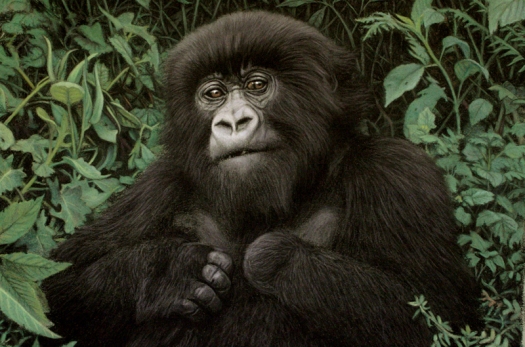
Detail of “Mountain Gorilla Juvenile With Left Hand Missing”– This is the state of the (upper half of) the painting at the moment. I’ve been working on the piece for a while, one of those paintings that just seems to hang around the studio in order to get resolved at some point.
I encountered this youngster on one of my gorilla treks in Rwanda. His hand had been caught in a poacher’s snare– the hand shriveled as the wire cut to the bone. Eventually, the withered hand fell off. This little guy– quite young, but somehow seeming very very old to my eyes– was lucky to escape with his life. He also has a “lazy eye”–strabismus– a condition exacerbated by inbreeding. The mountain gorillas live on a literal island in the clouds– a small postage-stamp remnant of the natural world completely surrounded by humanity in one of the most densely populated regions of Africa.

